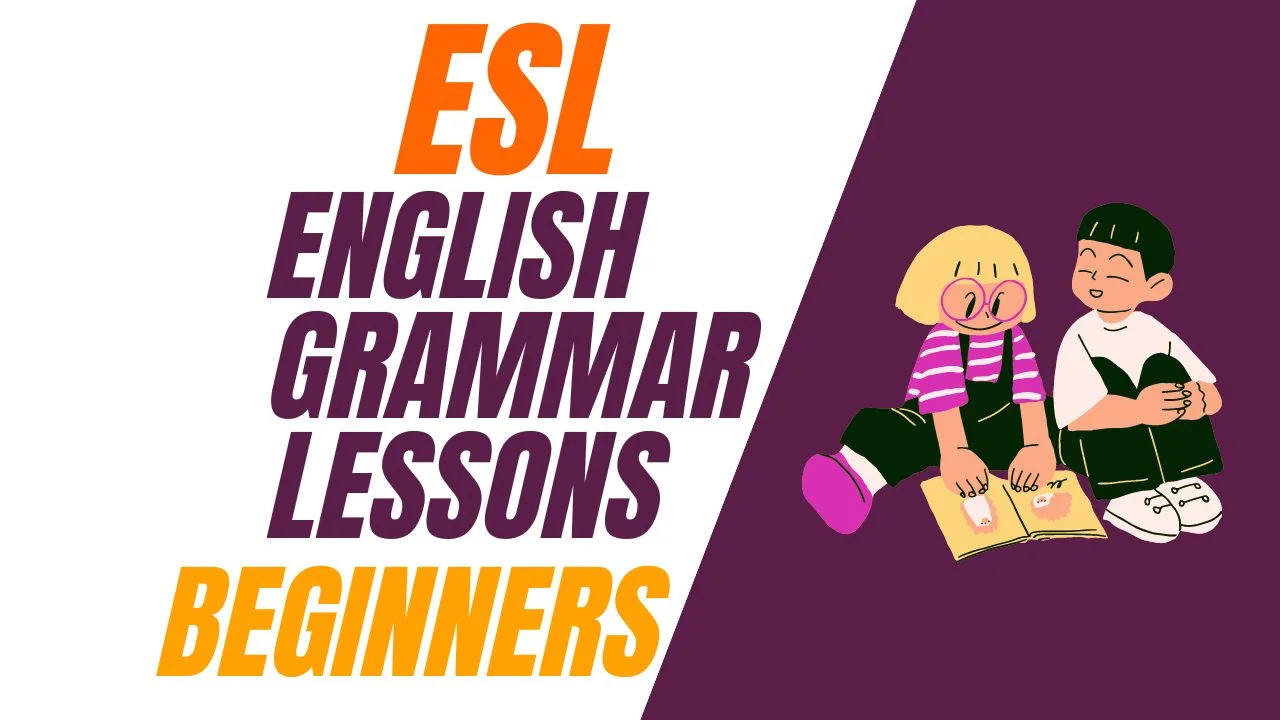Explore the foundational language skills with our 17 ESL English Grammar Lessons for Beginners. Perfect for novice learners, this comprehensive guide covers essential grammar concepts in an engaging and accessible format.”
Basic Grammar Lessons for ESL Students
Learning English as a second language (ESL) is an exciting journey, and understanding grammar is a crucial aspect of achieving proficiency. In this comprehensive guide, we’ll explore 16 essential ESL English grammar lessons designed specifically for beginners.
Beginners’ English Grammar Course for ESL Students
ESL English Grammar Lessons for Beginners encompass the following grammar topics to aid those learning English as a Second Language.
- Parts of Speech
- Sentence
- Subject and Predicate
- Nouns
- Number
- Gender
- Pronouns
- Adjectives
- Verbs
- Adverbs
- Prepositions
- Conjunctions
- Interjections
- Articles
- Tenses
- Degrees of Comparison
- Subject-verb agreement
People also ask
| Conversation and Speaking |
| ESL Speaking Questions for Beginners |
| ESL Conversation Topics for Beginners |
| ESL Conversation Topics for Intermediate Students |
| 26 Engaging ESL Conversation Topics for Adults 2024 |
| Daily English Writing Practice |
| 19 Exercises Tips to Improve English Writing Skills |
| 13 Writing Exercises for Beginners in English 2024 |
Foundations of English Grammar
Mastering the foundations of English grammar is the key to building a solid language base. Whether it’s understanding parts of speech or sentence structure, grasping these basics lays the groundwork for effective communication for ESL English Grammar Lessons for Beginners.
ESL Grammar Lessons for Beginners
1. Parts of Speech
Words are divided into different kinds or classes according to the purpose that they are used for. The different kinds of words are called Parts of Speech. – J.C. Nesfield
Different Parts of Speech with Examples
Parts of Speech can be divided into eight classes the function they perform in sentences.
1. Noun: The Taj Mahal is one of the seven wonders.
2. Pronoun: He can make it easier.
3. Adjective: She is as beautiful as a rose.
4. Verb: Mother cooks food.
5. Adverb: Barking dog seldom bites.
6. Preposition: The book is on the table.
7. Conjunction: Do or die
8. Interjection: Hurrah! we have won the match.
2. Sentence
A sentence is a group of words that are arranged in a way to convey complete sense.
Sentences are of five types (5) in English according to meaning or theme.
(a) Declarative Sentence.
(b) Interrogative Sentence.
(c) Imperative Sentence.
(d) Optative sentence.
(e) Exclamatory sentence
3. Subject and Predicate
All sentences contain two parts – Subject and Predicate. The subject part refers to a person or thing about whom or what we are speaking. The part that tells us about the subject, is called Predicate part.
Examples of Subject and Predicate
| Subject | Predicate |
| 1. Rohan | is playing cricket. |
| 2. I | am going to school. |
| 3. This blackbird | flies. |
4. Nouns
“Noun is a naming word”. A noun is used to denote the name of something by a word whatever we see, touch, or feel.
Examples:
(a) Amartya is a good boy.
(b) The dog is a faithful animal.
(c) The army reached there in time.
(d) Iron is a very useful metal.
(e) Kindness is a great virtue.
In the above sentences, Amartya (name of a person), animal (name of a group of animals), army (name of a group of people), Iron (name of a thing or substance), and kindness (name of a group) stand for Noun.
5. Number
When a noun refers to one person, one animal, or one thing, it is in the Singular Number. When a noun refers to more than one person, animal, or thing, it is in the plural Number
Example 1:
- One boy is playing football.
- Many boys are playing football.
Example 2:
- One horse is running.
- Many horses are running.
“One” denotes a Singular Number. So, ‘One boy’ and ‘One horse’ refer to Singular Numbers.
“Many” refers to “more than one” i.e. Plural Number. Both “Boy” and “Horse” are Common Nouns in Example 1 and Example 2. So, ‘Many boys ‘ and ‘Many horses’ refer to Plural Numbers.
There are Two Numbers in English. One is (1) a Singular Number and the other is (2) a Plural Number.
6. Gender
Gender in English is mainly the male-female distinction of Common Nouns. Nouns may be of four genders in English.
Masculine gender indicates the names of male persons or animals. For example, king, prince, gander, and fox.
Feminine gender indicates the names of female persons or animals. For example, queen, princess, goose, and vixen.
Common gender indicates the names of males or females. For example, parent, teacher, cousin, and neighbor.
Neuter gender indicates non-living things (neither male nor female ). For example, books, pencils, a table, and stones.
7. Pronouns
A pronoun is a word used in place of a Noun.
Pronouns that stand for a person or thing are called Personal pronouns. For example, I, we, you, He, She, They, It, Me, Us, Him, Her, Them.
Example:
He gives you a pen.
They are playing football.
She told you that she was not ill.
8. Adjectives
An Adjective is a word that describes a noun or pronoun. We can call an adjective a describing word.
An adjective is generally used after or before a noun or a pronoun. According to position, an adjective can be divided into two categories –
- Attributive Adjective
- Predicative Adjective.
Attributive Adjective:
When an adjective is used before a noun to describe it, the adjective is called an attributive adjective.
Example:
- He is a good (Adj)boy ( N). – Adjective placed before a noun.
- I met a poor (Adj) man (N) – Adjective placed before a noun.
Predicative Adjective:
When an adjective is used after a noun or a pronoun to describe it, the adjective is called a predicative adjective.
Example:
- The boy (N) is good (Adj). – Adjective placed after a noun.
- The man (N) is poor (Adj). – Adjective placed after a noun.
9. Verbs
(1) Anita is a good girl.
(2) Tiger is a ferocious animal
(3) Anita has two brothers.
(4) The table has four legs
(5) Anita is singing a song.
(6) Birds are flying in the sky.
All the above-underlined words tell us what a person or thing is, what a person or thing has, and what a person or thing does. All these words are called Verbs.
A verb is a doing word. It describes an action.
It tells us,·
1. what a person or thing is.·
2. what a person or thing has.
3. what a person or thing does.
10. Adverbs
Adverbs are words that tell us more about verbs, adjectives, and other adverbs.
Example:
She walks fast.
Shelly sat quietly. (qualifying the verbs walk and sat)
Sania is very hungry.
Aslam is rather naughty. (qualifying the adjectives hungry and naughty)
This week has passed incredibly slowly.
Esha cleans her desk quite often. (qualifying the adverbs slowly and often)
11. Prepositions
A preposition is a word that shows the position of things and people in relation to someone, something or some place.
Some common prepositions are-
- in
- on
- of
- across
- off
- through
- before
- behind
- near
- over
- beside
- inside
- outside
- with
- to
- into,
- under
- except
- between
- till
- Until
12. Conjunctions
A word that connects two or more words, or a sentence is called a conjunction.
Example:
- for
- and
- nor
- but
- or
- Yet
- So
All the above words help to join words, phrases, or sentences.
13. Interjections
We use interjections to show a strong or sudden feeling of happiness, sadness, surprise, or hurt.
Oh! Oh dear! Wow! Ouch!
These words are followed by an exclamation mark. We use a capital letter after the exclamation mark.
● Wow! This is lovely.
● Ouch! I hurt my toe.
Note: All interjections are exclamations, but all exclamations are not interjections.
14. Articles
We use the articles ‘a‘ or ‘an‘ before a singular noun. We use a or an when we talk about a common noun for the first time. A and an are indefinite articles.
We use a where the noun is singular and begins with a consonant sound.
1. This is a parrot.
2. I can see a giraffe.
We use an when the noun is singular and begins with a vowel sound.
1. This is an orange.
2. Golu has an egg every day.
The word the is also an article. We call it the definite article.
1. We use the before nouns starting with consonants as well as vowels.
We use the-
1. As we have already talked about the thing → I am reading a new book now. The book is very good.
2. when we talk about something in particular → The principal is busy.
3. when there is only one of something → The Earth moves around the Sun.
4. before a plural noun → The watermelons are in a basket.
5. before the names of buildings, rivers, seas, oceans, hills, mountains and mountain ranges → The Indian Ocean.
15. Tenses
Tense is the form of the verb that refers to the time of an action. Time is the duration of work and action is the work done. The different forms of verbs are called Tenses. The tense of a verb shows the time of an action or the state of being.
There are three types of tenses.
(i) Present Tense: She sings a song. ( Time that is now )
(ii) Past Tense: She sang a song. ( Time that has passed )
(iii) Future Tense: She will sing a song. ( Time that is yet to come )
16. Degrees of Comparison
Adjectives can be used to compare people and things. Adjectives are of three degrees-
- positive
- comparative
- Superlative
An adjective is said to be in the positive degree when there is either no comparison or a comparison is made using so…as/as…as.
Example:
- It is cold today.
- Latha is a tall girl.
- He is as intelligent as his father.
- I am not so old as you are.
An adjective is said to be in the comparative degree when two people or things having the same quality are compared using
Example:
- Yesterday was colder than today.
- Priya is taller than Latha.
An adjective is said to be in the superlative degree when three or more people or things having the same quality are compared.
Example:
- Sunday was the coldest day of the week.
- Maya is the tallest girl in the class.
17. Subject-verb agreement
Subject-verb agreement means the combination of verbs with their subjects in sentences according to Number and Person.
In a sentence, the subject must agree with the verb. If the subject is singular, the verb must also be singular. If the subject is plural, the verb must be plural.
Example:
- He is a good dancer. (singular subject and singular verb)
- They were late for the party. (Plural subject and plural verb)
Congratulations on completing these 17 ESL English grammar lessons for beginners. Remember, language learning is a continuous process. Embrace curiosity, practice regularly, and watch your English proficiency grow.
FAQs
How often should I practice these lessons?
Consistency is key. Aim for daily practice to reinforce your learning.
Are there any recommended apps for ESL grammar practice?
Yes, several apps offer interactive exercises; explore options like Duolingo and Grammarly.
What’s the most challenging grammar concept for beginners?
Many find verb tenses and subject-verb agreement challenging initially.
Can I become fluent in English by mastering these lessons?
While these lessons are foundational, fluency requires practice in real-life conversations.
Is it okay to make mistakes while learning grammar?
Absolutely! Mistakes are part of the learning process; don’t be afraid to make them.







